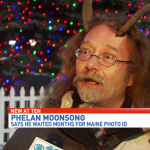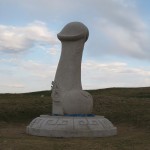Years ago, when I was deciding whether to leave the Mormon church, one of the recurring thoughts I had was that, by continuing to associate with the Mormon church, I was (mis-)representing to the world that I shared all the same beliefs and the same ordering of values as the Mormon church. I felt that, the Mormon church no longer represented me, so it was disingenuous for me to go on representing the Mormon church. To put it bluntly, I was embarrassed to be Mormon. I was attending law school and I was increasingly sympathetic to the three perceived “threats” to Mormonism identified by Mormon apostle Boyd Packer: homosexuals, feminists, and intellectuals. It got so that I stopped telling people that I had attended Brigham Young University for my undergraduate degree.
After leaving the Mormon church, I slowly came to realize that the Mormon community is not as homogenous in beliefs or values as I had thought. There are plenty of gay Mormons, feminist Mormons, and intellectual Mormons. While the LDS church is an authoritarian institution with a more or less well-defined orthodoxy, there are plenty of people who feel more or less comfortable in the church community who do not share all of the beliefs and value orderings as the leaders of the church. This may come as no surprise to someone who was not raised Mormon. But from a very early age I had been taught by Mormons that Mormons were all the same, that we all believed the same things and shared the same values. This belief was reinforced by my observations of what people said and did at church. Little did I know that beneath the ritualized conformity of the Mormon Sunday worship service, there was a surprising amount of diversity. I still feel that the Mormon church institution actively works to level out that diversity, but it persists nonetheless. While I have no doubt I would ultimately have decided to leave the Mormon church in any case, I think that if I had realized this earlier, then my decision would have seemed somewhat less obvious to me at the time.
Years later, I discovered something called Paganism. As I have written before here on this blog, I discovered Paganism in books, and it was not for several years until I began to interact with the Pagan community — through CUUPS (the Unitarian Universalist Pagans), Pagan Pride Day, pagan festivals and conventions (like Pagan Spirit Gathering and Pantheacon), and through other public Pagan rituals. While it may seem strange to non-Pagans that a person would begin to identify as Pagan before ever having met another Pagan, this is actually not uncommon in the Pagan community. Many Pagans today discover Paganism through books or the Internet, and some may never interact personally with the larger Pagan community.
When I did begin interacting with other Pagans at public events though, I was . . . disappointed. There, I said it. In fact, I was embarrassed. Paganism for me was a rich and complex tradition with the potential to transform consciousness and, dare I say, save the soul of the world. But the public face of Paganism seemed to me silly and naive. I’ve written before what I love about Paganism and what I hate about Paganism, so I’m not going to go over it all here again. And I’ve laid out what my Pagan beliefs are before also, so I’m not going to rehash that. What I want to do here is explore this embarrassment.
This experience of embarrassment has come to a head in several ways recently. First, I recently had a job change and had to interview for the new position. I realized that my prospective future employer may very well Google my name. And that would lead them directly to my Pagan identity. Not only do I blog here, but I have contributed posts to the Humanistic Paganism community blog and have been a more or less active commenter on other well-known blogs, like Star Foster’s now-defunct Patheos blog. When I first corresponded with B.T. Newberg, who runs the Humanistic Paganism blog, he very easily connected me to both the American Neo paganismwebsite I was maintaining at the time and the website of my employer.
I had intentionally used my name here and elsewhere as a matter of principle, and I admire other people who do the same. I feel that the use of “craft names” and internet handles perpetuates a feeling of persecution that many Pagans feel, as well as perpetuating the perception that Paganism is not a serious religion. (Just check out one of the many Pagan name generators online and you’ll see what I mean.) However, when it came time to change jobs, I seriously considered contacting B. T. Newberg to ask him to remove my full name from my posts at the Humanistic Paganism blog. And I just saw that B.T. had another author who did remove his contribution entirely due to employers Googling his name. In the end I didn’t, at least in part because of the futility of it (since changing my name on posts would not have eliminated the Google “hits” immediately), but also because I am proud of my Paganism.
And here’s where we get to the crux of it. I was not embarrassed about my Paganism. I was embarrassed by “their” Paganism. I was afraid of being associated with the public face of Paganism as I have come to know it. Basically, I found myself feeling something similar to what I felt years ago when I was leaving the Mormon church. This embarrassment came up a couple more times recently: once when my father told me that a friend of his was checking out my blog and again when a couple I go to the UU Church with, whom I greatly admire, asked me if I attend the CUUPS rituals, because they were thinking about checking it out. Both time I had this same gut reaction — a fear that they would think I was like “those other Pagans”.
Now all of this will probably seem very harsh to some ears, and I expect some people are going to give me slack for it. I probably deserve it — I’m not nearly as inclusive as many Pagans are. But I know I am not alone in this. One of the favorite pastimes of Pagans is to mock “those other Pagans” as being too [fill in the blank]. Paganism has very little of that sense of unity that so characterizes Mormonism. And yet, Paganism does have a public face. It is the face that is presented through CUUPS, through Pagan Pride Day, and through other public Pagan events. Some parts of these events I do like, but a lot of it leaves me feeling mostly embarrassed.
That was why I was excited to read Teo Bishop’s recent post “I Felt Ashamed at Pagan Pride”. It turns out that Teo’s embarrassment was not so broad as my own. His specific embarrassment concerned how a certain public ritual was handled in the face of some heckling by spectators. But Teo’s post did touch on some of the things I find very embarrassing about Paganism: The ritual at issue involved imagining “a ball of white light” which enveloped the circle. And the purpose of this ritual as stated was “protection”, which was expressed by the distribution of stones to everyone which had been blessed and inscribed with a pentacle and the word “protection.” Teo was embarrassed about the ritual because of how it excluded the spectators. But I would have been embarrassed, and in fact I am embarrassed reading about it, for different reasons. To me, the ritual Teo describes is flighty New Age drivel and not fundamentally different from praying to an all-powerful monotheistic God to save us from everything bad in the world. This single ritual would not be a major concern for me, but for the fact that I think this type of ritual is characteristic of the public face of Paganism. And it is something I absolutely do not want to be associated with.
I came to Paganism via feminist theaology with its pantheistic conception of divinity informed by process theology. This kind of Paganism offers a radically new conception of divinity and its relation to humanity. The Pagan Goddess is not “Yahweh in drag”, but a whole new kind of God. With Catherine Madsen, I affirm, “as someone who has known only the Father God, but as someone who has known the world: its droughts and floods, its extremes of climate, its strange combination of tender bounty and indifference”:
“However certain one may be that one is loved by some presence in the universe–and it is possible, at moments, to be very certain of that–that same presence will kill us all in tun, will visit our lovers with sudden and devastating illness, will freeze our crops, will age our friends, and will never for one moment stand between us and any person who wishes us harm.”
(Catherine Madsen, “If God is God She Is Not Nice: Roundtable Discussion”, in the Journal in Feminist Studies in Religion, vol. 5 (1989)). The Pagan deity I know as “Goddess” is not a comforting deity. In Starhawk’s words, the Goddess is “All Possibility” and “all means all”:
“I proliferate, I don’t discriminate. But you have the knife. I spin a billion billion threads, now, cut some and weave with the rest.”
(Starhawk, The Fifth Sacred Thing). Thus, I believe the only “protection” to be found is that which we carve out of the real world with our own hands, not in spells or prayers. (For more on this, see my post “God is Change. Shape God.”)
As a humanist and a naturalist, I cringe at the sound of anything that smacks of magic: whether it be an spell of protection or a prayer to God to save us from disease, disaster or death. Similarly, as a Jungian, I am suspicious of all forms of religion which seek to divide the world (or ourselves) into good parts and bad parts and banish the latter. Paganism, as I understand it, is radical in its acceptance of the world as it is, the constructive and the destructive; the tragic side of life must be integrated, not exiled.
Admittedly, my “brand” of Paganism, informed by feminist thealogy, process theology, humanism, and Jungian psychology, is not representative of Paganism generally or even common. But I believe that only when Paganism is informed by these things, as well as the insights of “deep ecology” does it truly represent a possibility for transforming ourselves and the world. The ritual which Teo described reflects not just a variation on a theme. It is a Paganism that I do not recognize. It is a Paganism of wishful thinking and self-delusion. It is a Paganism which suffers from the same flaws as the 60’s counterculture hippie movement from which it sprang: an overemphasis of idealism over realism, endemic disorganization, and an inability to communicate its vision to the wider culture. And it is frankly a Paganism I am embarrassed to be associated with.
I suppose this is unavoidable in any religious community. Mormons have to deal with the image of fundamentalist polygamists. Catholics have to deal with the image of pedophile priests. Conservative Christians have to deal with the image of the Todd Akins of the world. Muslims have to deal with the image of the jihadists. I guess, in the big picture, its not such a big deal that I have to deal with the image of New Age “white lighters” and hippie nudists. Still, it’s enough to make me wonder sometimes if “Pagan” is what I want to be.















